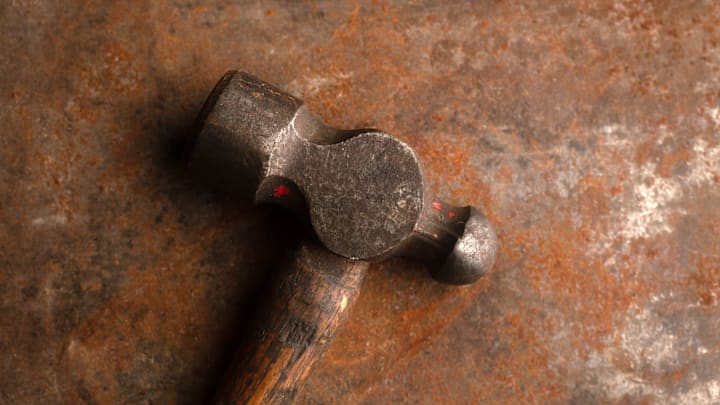Most people are familiar with the standard household claw hammer: a blunt-force instrument with a V-shape on the opposite end for extracting nails. But some toolboxes may also be equipped with what’s known as a ball peen hammer, a two-headed tool with one flat side and one rounded side. The ball part of the name makes sense, but what’s with the peen?
The Origins of Peen
According to the Oxford English Dictionary, peen originated in Scotland and England in the 1600s, referring to the pointed end of a hammer. It wasn’t sharp like a claw hammer, but instead came to a fine taper for driving nails in tight places where a larger head wouldn’t fit.
Though the term may have roots in early Germanic versions of pin—which itself dates back to Old English—it probably passed through early Scandinavian before English borrowed it back as peen in the “pointed hammer end” sense. It might also have been influenced by the verb peen, another likely Scandinavian loan that means “to beat thin with a hammer”: Imagine a blacksmith refining steel for a sword by smashing the heated material with a hammer as it rests across an anvil.
What about peen as slang for “penis”? |
|---|
Yes, peen is also a popular colloquial term for “penis,” which the OED is able to date to 1974; it was formed through a shortening of the original word. Peenie, another slang term for “penis,” goes back to the 1940s. |
Enter the Ball Peen Hammer
A tapered peen had its uses, but eventually, the tool evolved in another direction—a ball peen hammer had a peen that was rounded rather than pointed.
The term ball peen hammer first saw print in 1874, when a mechanic’s dictionary referred to it as a “metal worker’s hammer with a spherical peen.” The ball side isn’t used to drive nails; instead, its purpose is to strike metal for shaping. One might, for example, want to have a rounded surface to craft contours for armor.
Because people are less likely to be hand-shaping knights’ apparel these days, the ball peen hammer grew to serve other functions. It can be used to pound a rivet, or metal fastener, into place; it can also be used to create decorative marks in metal. Some “distressed” materials intended to look worn might be the work of a ball peen.
Can you use a ball peen hammer in place of a claw hammer? Sometimes, but not always. Ball peen hammers tend to be smaller and thus not quite as powerful as a conventional hammer, which might not be best for driving fasteners. One should never, obviously, try to aim for a nail with the peen side, unless you enjoy spending time at urgent care.
Catch Up on the History of Other Tool Names:
